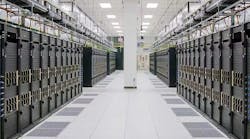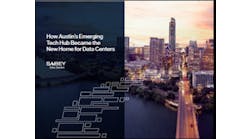There’s a popular myth that the rise of the cloud means the death of the data center. This is entirely backward. The shift to cloud computing will accelerate the construction of massive data centers and high-speed networks. As our society shifts to a digital economy, there will be an explosion of data. This data must live somewhere, and flow across the global Internet to users’ doorsteps.
In the real world, there is no “cloud.” It all lives in data centers. Software is eating the world, but it doesn’t have a seat at the table without data center infrastructure.
To be sure, the shift to the cloud model will bring major changes for the data center industry. Workloads will consolidate in the largest and most efficient facilities. Established network hubs will assume a central role in the evolution of the cloud, connecting enterprises to their data and applications in third-party server farms. For the largest technology companies, cloud data centers will be the engines driving the growth of their digital empires.
[clickToTweet tweet=”In the real world, there is no cloud. It all lives in data centers” quote=”In the real world, there is no cloud. It all lives in data centers”]
A Changing Landscape
But there will also be data centers in new places, requiring providers to adopt new approaches to their infrastructure. Efficiency and economics will loom larger than ever, as cloud builders seek to match their compute capacity to the growing demand from cloud users.
At Data Center Frontier, the data center is our prism for telling a larger tale. We tell the story of the digital economy through the facilities that power the cloud and the people who build them. In writing about data centers and thought leaders, we will explain the importance of how and where these facilities are built, how they are powered, and their impact on the Internet and the communities around them.
We see several key themes driving the future of the cloud data center, which will be the focus of our coverage. Here’s an overview:
Scale: More Hyper Than Ever
The largest cloud facilities are getting larger, concentrating enormous amounts of cloud capacity on multi-facility campuses in places like Iowa, North Carolina, Oregon and central Washington state. As giant cloud players compete on price, these rural cloud hubs will become even more important, offering economies of scale in the form of abundant land, cheap power and cool climate.
These giant server farms are each pumping as much as $1 billion into the local economies of small towns and modest metros. Apple recently announced plans to invest $2 billion to build new data centers in Ireland and Denmark, while Amazon will spend up to $1.2 billion on three new server hubs in central Ohio.
Servers packed into a Microsoft cloud data center. (Image: Microsoft)
As the cloud gains traction, the pace of new data centers announcements is accelerating. On June 2, Facebook, Microsoft and Google announced data centers expansions on the same day, unveiling five new data centers across the globe.
Demand is projected to grow as adoption spreads beyond the “cloud native” startups and small businesses. For data center service providers, the biggest opportunity is in enterprise companies moving their applications out of in-house data centers. This shift has been underway for years, with enterprise migrations often lagging the hopes and expectations of providers. But there are signs that cloud services have reached a level of maturity and executive mindshare that this may begin to accelerate.
Bernard Golden, a cloud thought leader and vice president of strategy at ActiveState, believes the recent reversal of the long decline in server sales is the first sign of a larger shift from enterprise data centers to cloud providers. Noting that the uptick in first quarter server sales extends beyond the hyperscale sector, Golden cites Jevons Paradox – the tendency for usage to accelerate as a service becomes cheaper and more efficient.
“Last quarter’s jump (in server sales) will come to be seen, in retrospect, as the inflection point where computing’s nature changed,” Golden writes at CIO. “Simply put, we are on the cusp of an enormous transformation as computing resource provisioning transitions from expensive and complex to cheap and low-friction.”
Golden predicts this shift will bring “massive, massive data center construction by the biggest providers. We will see tens of billions of dollars invested over the next decade as providers struggle to keep up with the demand for cloud computing.”
The Cloud Extends to the Edge
Much of today’s cloud capacity is concentrated in these large data center campuses, but that will soon begin to change. As cloud services penetrate every corner of the global economy, data must reach new populations, filling in the empty spaces in the data center map. This trend will be seen in secondary business markets in the U.S., at the “edge” of established networks, and in emerging markets around the world.
Data center geography may also be shaped by privacy and compliance concerns, which threaten to redraw the boundaries for where data resides and where new facilities are built.
Industry observers say the convergence of cloud computing, Big Data and the Internet of Things will require the data center industry to expand well beyond the traditional “Big Six” markets – Northern Virginia, New York/New Jersey, Chicago, Dallas, Silicon Valley and Los Angeles – that have traditionally been magnets for third-party service providers.
An Allied Fiber modular colocation centers is lowered into place on the company’s fiber route in Florida. (Photo: Allied Fiber)
“The consumer device, and what we do with it, is driving content-based decisions about where the data center and network are located,” said Sean Farney, Head of Global Technology Operations at the Boston Consulting Group, who predicts the industry will be “filling in the blanks” in the U.S. heartland.
“Distributing content to mobile end points is the game,” said Hunter Newby, the CEO of Allied Fiber, which is deploying “bite-sized” modular colocation centers along dark fiber routes. “That’s a big business driver.”
[clickToTweet tweet=”‘I think there’s going to be an explosion at the edge.’ Chris Crosby” quote=”‘I think there’s going to be an explosion at the edge.’ Chris Crosby” ]
“It’s very important that content gets to the edge user,” said Clint Heiden, Chief Commercial Officer of EdgeConnex. “The adoption of cloud simply means that the cloud must grow and move to the edge. To be robust, it’s got to be able to offer performance.”
As data moves to the edge of the network, data center deployment will adapt to the varying levels of demand across the network. Facilities in second-tier and edge markets will be smaller, requiring different design decisions and expansion models.
“In the center are mega-data centers,” said Don Beaty, founder and CEO of pioneering data center engineering firm DLB Associates. “I think the edge will be smaller data centers, and could have quite a bit of capacity needs. They won’t be huge facilities, but I think (estimates of demand) are missing by an order of magnitude. There’s a lot of work to do.”
Firms targeting growth opportunities in secondary markets include Compass Datacenters, EdgeConnex, vXchange, 365 Data Centers, ByteGrid, Park 10, ViaWest and Cologix, among others.
Google’s Jupiter network block, which drives massive data across its network. (Image: Google)
Chris Crosby, CEO of Compass, expects to see different deployment models as data moves further from the core of the Internet. “You’ll have your edge data center, and after that you’ll have micro data centers,” said Crosby. “It’s going to be a lot like caching. The big content providers want to keep data off the main network. I think there’s going to be an explosion at the edge.”
The largest cloud builders will continue to focus on massive regional cloud campuses. But they’re also starting to pay a lot more attention to their network, which serves as the primary tool to deliver information to the network’s edge. Google just unveiled details of its data center network, which it says can deliver 1 petabit per second of total bisection bandwidth — enough to transmit the entire contents of the Library of Congress in under one-tenth of a second. That capacity helps Google provide speedy page delivery across its global network. As cloud services grow, that may change.
“The campus model still makes a lot of sense,” said Joe Kava, Vice President, Data Centers for Google. “But we may have to eventually have a more distributed approach. You’re going to have to have more edge cache nodes. It won’t replace the campus system, but we might see more of that. We have to be prepared to react to the business imperatives.”
Meanwhile, the Internet titans are protoyping new technologies to deliver wireless access to under-served markets around the globe. As these initiatives succeed and grow, data will seek residence in new locations. The data flowing through balloons, drones and satellites delivering the Internet will need to live somewhere, creating demand for data centers in emerging markets with less infrastructure than the U.S. There will be data centers in these new places, but they may be built and powered very differently than the server farms of Silicon Valley.
Design Drives New Opportunities
Design will continue to serve as a differentiator as new capacity is deployed at all points of the network. New thinking is busting old form factors for servers, racks, rows and rooms. Designs employing pre-fabrication and lean construction techniques will become especially important in supporting workloads in smaller markets and new geographies. This demand will help modular data centers move beyond many of the resistance points associated with the early generations of containerized “data center in a box” products.
“It’s about pre-fabrication, not boxes,” said Amy Kulka-Marks, President of XSite Modular, who uses the term MMC – short for “modern methods of construction” – in conversations about modular data center designs.
“I think we’ve entered the second phase of evolution for the data center,” said Farney of Boston Consulting, who managed one of those early container farms for Microsoft. Farney says data center design has moved past the “artisanal phase” and into mass production. “Everyone has recognized that you need to do pre-fabrication somewhere in the supply chain. It’s definitely the way forward.”
Pre-fabrication and lean construction also factor into the plans at Facebook, which is implementing its vision for a “rapid deployment data center” in a new building at its Lulea, Sweden campus. The company compares it to the snap-together furniture popularized by IKEA, with many power and cooling components delivered in modular form, and says the new approach will reduce material use and accelerate build time.
A Flexenclosure eCentre modular data center being assembled in Mozambique. Flexenclosure’s designs have been used by telecom firms to deploy capacity in several countries in Africa. (Image: Flexenclosure)
Modular form factors will also play an important role as data center capacity is deployed in new parts of the emerging world. One example in Flexenclosure, which has used flexible modular “eCentre” designs to build IT facilities for telecom counties in Africa, including some that are supported by solar power. Another example is RuggedPOD, an enclosure designed by the Open Compute Project to operate outdoors by immersing servers in dielectric fluid.
Deploying capacity in small chunks is critical to making the Internet work in new geographies. Data centers are enormously expensive, and the explosive growth of cloud services will test the industry’s ability to model growth and plan for the future. Aligning cost and capacity will be paramount. The cloud builders must never forget the lessons of history and the overbuilding of the dot-com bust. The movement of data to the edge and into emerging markets will require a sharp focus on discipline, design and deployment models.
“There’s tremendous opportunities in these smaller cities and new markets,” said Newby of Allied Fiber, a veteran builder of Internet infrastructure. “But it’s a lot of work, and you have to know what you’re doing.”
It also means developing deployment models for new markets that gain support of investors. Much of the growth in the data center market has been funded by private equity firms, who are careful in assessing risk and opportunity. Phased growth that allows cloud builders to deploy capital gradually, closely matching capacity to demand, will be the sweet spot.
Pre-fab modules allow data center developers to place capacity near energy sources, as seen in BASELAYER’s collaboration with utility SRP in Phoenix, which deploys modular data centers near bulk transmission lines. It’s one of a number of examples of data center builders using new designs to rethink their relationship with power.
The Role of Renewable Energy
Electricity is the lifeblood of every data center. Some of these new facilities will seek new sources of energy, especially renewable technologies such as wind and solar, as well as landfills and other sources of biogas. Other technologies, such as Bloom Energy fuel cells being adopted by Equinix and eBay, may prompt consolidated approaches to power architecture.
“Certainly, the Internet companies are more and more interested in the content of the grid, and many of us have set up an ambitious goal of being powered by 100 percent renewables,” said Joe Kava of Google. “There’s no grid in the world that can provide 100 percent renewable energy. We’d like to source entirely renewable energy. If the utilities would sell it to us, we’d do it.
“Customers and end users of cloud companies are saying ‘this is part of our value system,'” Kava continued. “They want to know where the energy that’s powering their cloud is coming from.”
[clickToTweet tweet=”‘The tipping point for renewable will be utility-scale energy storage.’ Joe Kava” quote=”‘The tipping point for renewable will be utility-scale energy storage.’ Joe Kava” ]
“It’s clear to me that enterprises are truly interested in reducing their carbon footprint,” said Peter Gross, Vice President of Mission Critical Systems at Bloom Energy. “Companies have very clear corporate objectives.”
Gross noted that earlier this month a group of 19 Amazon Web Services customers (including HootSuite, Tumblr and Upworthy) signed a letter to AWS, asking the company to release additional details about the carbon footprint of the data centers hosting their cloud apps.
A Tesla Powerwall battery. (Image: Tesla Motors)
Amazon has since announced plans to source 80 megawatts of renewable energy from a solar farm in Virginia, and is also testing a new 4.8 megawatt Tesla stackable battery unit. “We’ve been working closely with Tesla for the past year to drive innovative applications of high-capacity battery technology in data center applications, with the ultimate goal of reducing the technical barriers limiting widespread adoption of renewables in the grid,” said James Hamilton, Distinguished Engineer at AWS.
Google’s Kava says the Tesla batteries have potential, but even larger opportunities may lie ahead.
“I think the tipping point for utility-scale renewable will be the next-generation of utility-scale energy storage,” said Kava. “As soon as real large-scale energy storage is available, I think that will bring more renewables in the grid. Renewables by nature are not base-load compatible, because they fluctuate. Large-scale storage could be tapped on a rainy or windy day. That’s going to be a key enabler. In the next five to 10 years, we’ll see some advancement in this area.”
Energy Efficiency
Environmental idealism may drive some firms to pursue renewable energy, but cost will continue to be the primary “green” motivation. Efficiency can slash costs, with savings from small gains rippling across tens of thousands of servers and entire fleets of data centers. Industry innovators will continue to lead with efficiency, targeting opportunities from the chip to the grid.
“The best energy is the energy you don’t use in the first place,” said Kava.
Energy efficiency remains at heart of the industry’s approach to “green” data centers. (Photo: IBM)
Sharing of best practices via industry conferences has brought energy efficiency outside the “cone of silence” that existed for years. The Open Compute Project has created an ecosystem that is making made energy-efficient equipment and designs more accessible than ever, and creating a growing market of suppliers and customers.
But much of the enterprise computing world remains woefully inefficient. A recent survey by IDC of 400 enterprise data center managers found that two thirds had a Power Usage Effectiveness of 2.0 or higher, compared to averages of 1.2 for cloud-scale facilities and about 1.5 for the most efficient enterprise operators. Another recent report from Stanford University and Anthesis found that roughly 30 percent of the servers deployed worldwide are “comatose” and have not delivered information or computing services in the last six months. That’s clearly not happening in the hyperscale environments, which are insanely focused on high utilization.
Enterprise IT has a history of being conservative and resistant to new approaches. The efficiency of cloud infrastructure offers another powerful incentive for enterprises to look to the cloud.
“What makes the cloud green is if enterprises stop building new data centers every time they run out of capacity, and instead turn to cloud providers,” writes David Linthicum at InfoWorld. “Enterprises spend millions of dollars each year adding data center infrastructure in support of many servers running at about 3 to 5 percent capacity. That wastes not only energy in usage, but also in the server’s creation, plus a whole lot of raw materials, too.
“Simply using public clouds is a huge step in the green direction. By sharing servers, we can do much more with much less – including power. Instead of shaming cloud providers for not being green enough, Greenpeace should be shaming enterprises into moving to cloud. That would have a much greater positive impact on the environment than focusing solely on the cloud providers.”
Data Center Frontier will be exploring these topics in depth in coming months. Follow us on Twitter, Facebook and LinkedIn.






